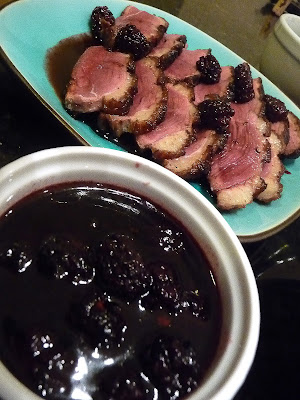It's been more than six months since my last entry here....I've been busy, and, when I have been cooking, I've mostly been repeating dishes that I've already posted here and/or forgetting to take pictures. Last week, the confluence of friends from grad school coming into town (some moving here, others passing through for a conference) and a hurricane provided the perfect excuse to stay indoors, cook lots of food, drink lots of good wine while we waited out the weather. The theme for this dinner party was Asian, or, more specifically, the Momofuku cookbook, which I have been reading a lot of but not cooking a lot of. Two of the four courses for this dinner were directly from the cookbook, one borrowed an ingredient from the cookbook to jazz up an old favorite, and the fourth dish involved me just cutting up some super fresh fish from Black Salt.
We started out the meal with a trio of raw fish. Here's an action shot of the dishes being prepared.
Here's a finished plate.
In the foreground are slices of ivory salmon (which I had never heard of before I walked into Black Salt looking for fish earlier that day) and king salmon. Being late August, king salmon are at their peak. I love the bold striations on this salmon. The ivory salmon was soaked in lime juice for a couple of seconds, then topped with a Spanish olive oil, smoked salt, and a lime zest. The king salmon was simply topped with some nice grassy tuscan olive oil and a bit of cracked pink peppercorns. The third dish, in the little bowls in the background, was an Ahi tuna poke. To make the poke, I cut the ahi into cubes (about 1 cm) and let it marinate in a mixture of soy sauce, sesame oil, and scallions with a dash of rice wine vinegar, and pinch of red pepper flakes. Just before serving, I tossed in some sesame seeds and then topped the poke with some strips of toasted nori.
Next came the veggie course: pan roasted asparagus and grilled king oyster mushrooms with miso butter and slow poached eggs.
Although I don't really like mushrooms, I really like the look of this dish. For some reason, the combination of the mushrooms and asparagus piled on top of the miso butter with the whole eggs has a really rustic, "farm to table" look to it. To make the slow poached eggs, you need to let the eggs sit in 140F water for around 45 minutes. If you were plating these individually (as they do in the Momofuku cookbook), you would spread out a bit of miso butter, artfully arrange the asparagus, and then place the poached egg across the top of the asparagus. In this family style preparation, the eggs would have all slid off to the side of the plate and, when serving, the yolks surely would have broken on the serving plate, leaving all of the yolky goodness behind. When served this way, everyone gets to crack their own egg, which is much cleaner and, besides, its fun.

The third course was miso and sake marinated sea bass with scallions, sunchoke puree, and bacon dashi. Sea bass is something
I've posted before. It's a great dish for a dinner party since all the flavor comes from letting it marinate for a long time (in this case, 48 hours), but it is really quick to cook. While we were eating the second course, I just stuck the fish under the broiler for about 10 minutes. You will need to flip the fish about half way through so it cooks evenly and the sugar in the marinade doesn't burn too much. The bacon dashi is a pretty straight forward (and brilliant) recipe from the Momofuku cookbook. Just steep some konbu in water for a few minutes, remove, then simmer some smokey bacon in the broth for about 30 minutes, chill, skim off the fat, and reheat before service. For the sunchoke puree, just peel the sunchokes, boil until tender, and puree in a food processor with butter. Season with salt and pepper. If you wanted to make this really rich, you could simmer the sunchokes in cream.

For the last course, we had steamed Chinese buns that Abby had made earlier in the day (see the freshly formed buns, waiting for the steamer below) with roasted pork belly, quick pickles, and other accoutrements.
Like the fish, the pork belly is a dish where all of the work is done ahead of time. I cured the pork belly in salt, sugar, pepper, and five spice powder for 24 hours, then roasted it at 450F for 45 minutes followed by another 3 hours at 250. Then, I chilled the pork belly over night, sliced it, and reheated it just before serving. Here's a finished pork belly bun.















